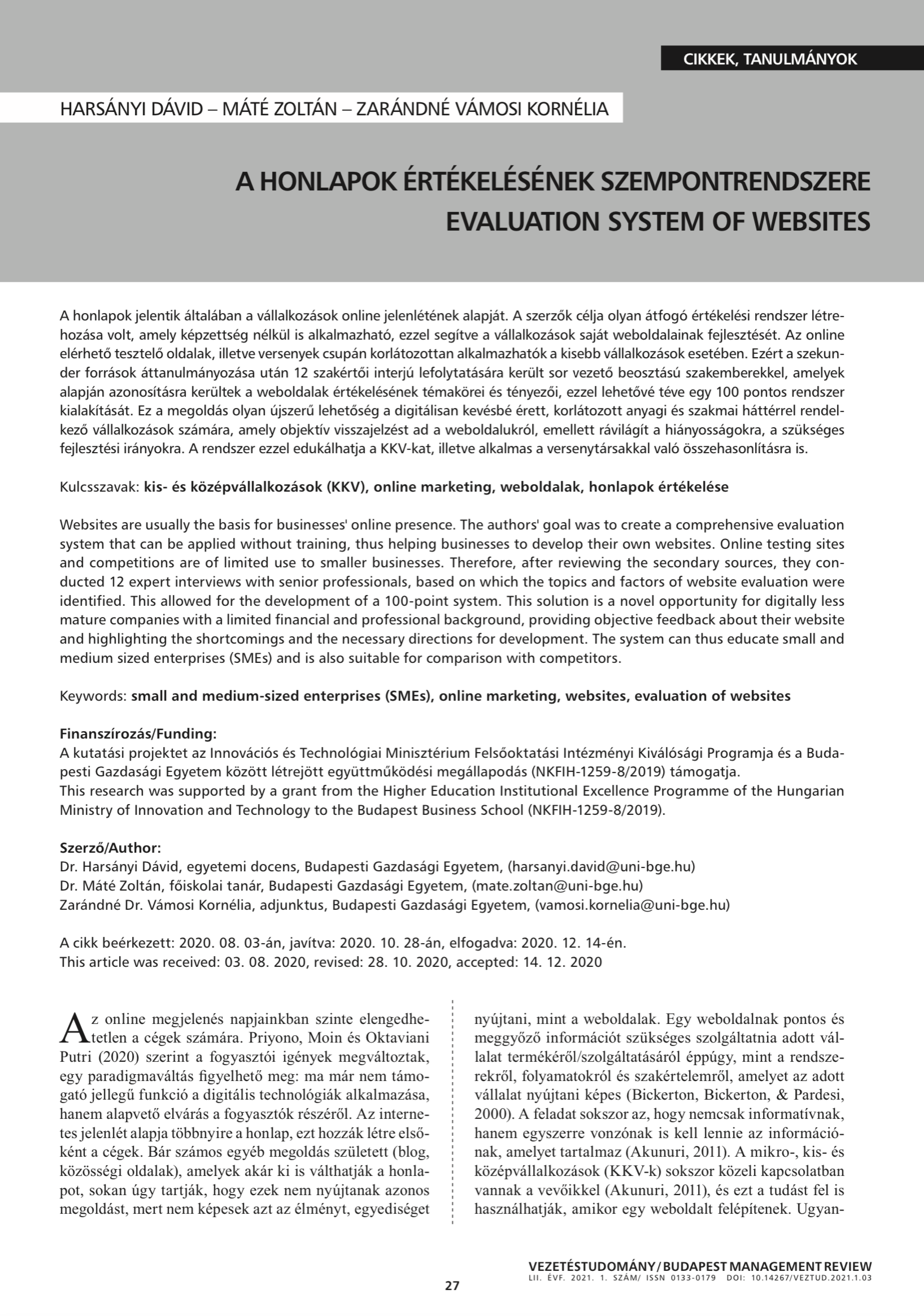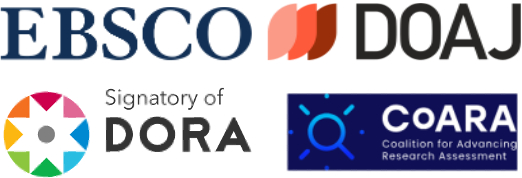A honlapok értékelésének szempontrendszere
DOI:
https://doi.org/10.14267/VEZTUD.2021.1.03Kulcsszavak:
kis- és középvállalkozások (KKV), online marketing, weboldalak, honlapok értékeléseAbsztrakt
A honlapok jelentik általában a vállalkozások online jelenlétének alapját. A szerzők célja olyan átfogó értékelési rendszer létrehozása volt, amely képzettség nélkül is alkalmazható, ezzel segítve a vállalkozások saját weboldalainak fejlesztését. Az online elérhető tesztelő oldalak, illetve versenyek csupán korlátozottan alkalmazhatók a kisebb vállalkozások esetében. Ezért a szekunder források áttanulmányozása után 12 szakértői interjú lefolytatására került sor vezető beosztású szakemberekkel, amelyek alapján azonosításra kerültek a weboldalak értékelésének témakörei és tényezői, ezzel lehetővé téve egy 100 pontos rendszer kialakítását. Ez a megoldás olyan újszerű lehetőség a digitálisan kevésbé érett, korlátozott anyagi és szakmai háttérrel rendelkező vállalkozások számára, amely objektív visszajelzést ad a weboldalukról, emellett rávilágít a hiányosságokra, a szükséges fejlesztési irányokra. A rendszer ezzel edukálhatja a KKV-kat, illetve alkalmas a versenytársakkal való összehasonlításra is.
Letöltések
Hivatkozások
Ainin, S., Parveen F., Moghavvemi S., & Jaafar N. I. (2015). Factors inf luencing the use of social media by SMEs and its performance outcomes, Industrial Management & Data Systems, 115(3), 570-588. https://doi.org/10.1108/imds-07-2014-0205
Akunuri, J. (2011). Internet marketing In Nwankwo, S., & Gbadamosi, A. (eds.), Entrepreneurship marketing – Principles and practice of SME marketing (pp. 171- 196) London: Routledge. https://doi.org/10.4324/9780429505461
Aranyi, G., & van Schaik, P. (2016). Testing a model of user‐experience with news websites. Journal of the Association for Information Science and Technology, 67(7), 1555-1575. https://doi.org/10.1002/asi.23462
Az Év Honlapja (2019). Elbírálás szempontjai. Retrieved from https://www.azevhonlapja.hu/elbiralas/elbiralasszempontjai
Bajaj, N., Steel, M., Ogden, S., & Rahman, K. (2020). Consumer motivations to create alternative consumption platforms, Australasian Marketing Journal, 28(3), 50-57. https://doi.org/10.1016/j.ausmj.2020.06.001
Bhuanaputra, K.W., & Giantari, K. (2020). The effect of perceived brand leadership towards consumer satisfaction and repurchase intention on e-commerce website. Russian Journal of Agricultural and Socio-Economic Sciences, 97(1), 66-73. https://doi.org/10.18551/rjoas.2020-01.08
Bickerton, P., Bickerton, M., & Pardesi, U. (2000). Cybermarketing: How to use the superhighway to market your products and services. Oxford: ButterworthHeinemann.
Bíró-Szigeti S., Petruska I., Szalkai Z., Kovács I., & Magyar M. (2015). Marketing hálózaton innen és túl. Egyesület a Marketing Oktatásért és Kutatásért (EMOK) Konferencia, Budapest.
Canziani, B., & Welsh, D. (2016). Website quality for SME wineries: measurement insights. Journal of Hospitality and Tourism Technology, 7(3), 266-280. https://doi.org/10.1108/jhtt-02-2016-0009
DESI (2020). A digitális gazdaság és társadalom fejlettségét mérő mutató (DESI). Retrieved from https://ec.europa.eu/digital-single-market/en/news/digital-economyand-society-index-desi-2020
Dörnyei K., & Mitev A. Z. (2010). Netnográfia avagy on-line karosszék-etnográfia a marketingkutatásban. Vezetéstudomány, 41(4), 55-68.
Carson, D. J. (2001). The evolution of marketing in small firms. European Journal of Marketing, 19(5), 7-16. https://doi.org/10.1108/EUM0000000004739
Dallago, B. (2012). SME policy and competitiveness in Hungary. Vezetéstudomány, 43(7-8.), 84-98.
Európai Bizottság (2017). Éves jelentés az európai KKVkról. Retrieved from https://www.smeacademy.eu/uploads/5/2/4/2/52422965/171217_annual_report_-_eu_smes_2016-2017.pdf
Eurostat (2017). Digital economy and society statistics – enterprises. Retrieved from https://ec.europa.eu/eurostat/statistics-explained/index.php/Digital_economy_and_society_statistics_-_enterprises
Fehér M. (2011). Online Marketing Akadémia: Hazai KKV online marketing körkép. https://www.onlinemarketing-akademia.hu/blog/2011/02/KKV-onlinemarketing-kutatas/
Foot, K. A., & Schneider, S. M. (2004). The Web as an Object of Study. New Media & Society, 6(1), 114-122. http://faculty.washington.edu/kfoot/Publications/Web-asObject-of-Study.pdf
Gáti M. (2015). Kis- és középvállalatok marketingtevékenységének befolyásoló tényezői – különös tekintettel az online marketingtevékenységre (PhD-értekezés). Corvinus Egyetem, Budapest.
Gáti M., & Csordás T. (2013). KKV-k tartalom- és marketingkommunikációja a közösségi médiában. In
Király Éva (ed.), Kiterjesztett marketing (pp. 335-348). Budapest: Budapesti Gazdasági Főiskola.
Gáti M., Csordás T., & Markos-Kujbus É. (2015). „Lájk első látásra?” – Mi inspirálja a márkák kedvelését az online térben, kis vendéglátóhelyek esetében? Egyesület a Marketing Oktatásért és Kutatásért XXI. országos konferencia, Budapest.
Gáti M., & Simay A. E. (2015). A kis cégek marketingje körüli tudományos hiátus okainak feltárása – avagy egy holisztikus kis- és középvállalati marketing modell. Egyesület a Marketing Oktatásért és Kutatásért XXI. Országos Konferenciája, Budapest.
Ghandour, A. (2015). Ecommerce website value model for SMES, International Journal of Electric Commerce Studies, 6(2), 203-222. https://doi.org/10.7903/ijecs.1403
Gilmore, A., Gallagher, D., & Henry, S. (2007). E-marketing and SMEs: Operational lessons for the future. European Business Review, 19(3), 234-247. https://doi.org/10.1108/09555340710746482
Herring, S. C. (2010). Web Content Analysis: Expanding the Paradigm. In Hunsinger, J., Allen, M. & Klastrup, L. (eds.), The International Handbook of Internet Research (pp. 233-249). Dordrecht: Springer Verlag. https://www.sfu.ca/cmns/courses/2012/801/1-Readings/Herring%20WebCA%202009.pdf
Hvg.hu (2009). A KKV-k kétharmada nem költ marketingre. Retrieved from https://hvg.hu/KKV/20090915_KKV_marketing_mikrovallalkozas
IMA (2019). Interactive Media Awards: Judging Criteria. Retrieved from https://www.interactivemediaawards.com/awards/criteria.asp
Jantsch, J. (2010). Szigszalagmarketing. Budapest: HVG Kiadó.
Joshua, S. (2016). Small Business Trends. Retrieved from https://smallbiztrends.com/2016/06/small-businessecommerce-trends.html
Kamaraonline.hu (2017). Így használják az internetet a magyar KKV-k. Retrieved from https://kamaraonline.hu/igy-hasznaljak-az-internetet-a-magyar-KKV-k/
Krippendorff, K. (2004). Content Analysis. An Introduction to its Methodology. Thousand Oaks: Sage Publications.
KSH (2017). A kis- és középvállalkozások jellemzői, 2017. http://www.ksh.hu/docs/hun/xftp/idoszaki/pdf/KKV17.pdf
Li, Y.-M., & Yeh, Y.-S. (2010). Increasing trust in mobile commerce through desing aesthetics. Computers in Human Behaviour, 26(4), 673-684. https://doi.org/10.1016/j.chb.2010.01.004
Lin, C., Huang, Y., & Stockdale, R. (2011). Developing a B2B web site effectiveness model for SMEs. Internet Research, 21(3), 304-325. https://doi.org/10.1108/10662241111139327
Lopes, L. A., & Melão, N. F. (2016). Website content and design in SME: insights from Portugal. International Journal of Electronic Business, 13(1), 70-97. https://doi.org/10.1504/ijeb.2016.075343
Martinez-Sala, A., Montserrat-Gauchi, J., & Alemany-Martinez, D. (2020). User Usable Experience: A threedimensional approach on usability in tourism websites and a model for its evaluation. Tourism Management Perspectives, 33(1), https://doi.org/10.1016/j.tmp.2019.100579
Máté Z. (2011). A magyarországi kis- és középvállalatok marketingszervezetének felépítése. Vezetéstudomány, 42(12), 59-67.
Miklovicz N. (2010). KKV marketing felmérés 2009 IV. http://brandtrend.hu/musor/KKVmarketing2009.pdf
Miklovicz N. (2016). Ezek a KKV-k legnépszerűbb marketingeszközei 2016-ban. http://www.marketing112.hu/KKV-marketingeszkoztar-2016/
Modern Vállalkozások Programja (2020). Meglepő előnyöket is hozott a koronavírus a KKV-k számára. https://mkik.hu/hirek/meglepo-elonyoket-is-hozott-akoronavirus-a-KKV-k-szamara.
Molenaar, C. (2012). e-Marketing – Application of information technology and the internet within marketing. New York: Routledge.
MRSZ (Magyar Reklámszövetség) (2019). Reklámtorta 2018. http://mrsz.hu/kutatas/reklamkoltes/reklamtorta-2018
MRSZ (Magyar Reklámszövetség) (2020). A 2019-es dinamikus fejlődés után több mint 160 milliárdos visszaesést vár a Reklámszövetség 2020-ban. https://mrsz.hu/cmsfiles/0e/8f/MRSZ_sajtokozlemeny _media-komm.torta_2019_2020.05.07..pdf
Nemeslaki A., Duma L., & Szántai T. (2004). e-Business üzleti modellek. Budapest: Adecom Kommunikációs Szolgáltató Rt.
Norman, D. (1988). The Psychology of Everyday Things. New York: Basic Books.
Polereczki Zs. (2011). A tej- és húsiparban működő kisés közepes vállalkozások marketingtevékenységének vizsgálata Magyarországon (PhD-értekezés). Kaposvári Egyetem, Gazdaságtudományi Kar,Kaposvár.
Priyono, A., Moin, A., & Oktaviani Putri, V. (2020). Identifying Digital Transformation Paths in the Business Model of SMEs during the Covid-19 Pandemic. Journal of Open Innovation: Technology, Market and Complexity, 6(4), https://doi.org/10.3390/joitmc6040104
Sasvári P. (2012). Az információs rendszerek kisvállalati alkalmazásának vizsgálata. Vezetéstudomány, 43(1. ksz), 56-65.
Sárosi I. (2018). Hogyan kezdj bele az online jelenlét kialakításához, ha KKV-t alapítottál? https://dimsz.hu/hogyan-kezdj-bele-az-online-jelenlet-kialakitasahozha-KKV-t-alapitottal/.
Szűcs K. (2019). Competitiveness of small enterprises in the online space among the Hungarian companies. Analecta Technica Szegedinensia, 13(2), 21-27. https://doi.org/10.14232/analecta.2019.2.21-27
Timár G. (2016). Miért nem élhetünk ma kommunikáció nélkül? https://piacesprofit.hu/KKV_cegblog/miertnem-elhetunk-ma-kommunikacio-nelkul/
Thomas, B., & Simmons, G. (1999). E-Commerce Adoption and Small Business in the Global Marketplace: Tool for Optimalization. New York: Business Science Reference.
Weare, C., & Lin, W-Y. (2000). Content Analysis of the World Wide Web: Opportunities and Challenges. Social Science Computer Review, 18(3), 272-292. https://doi.org/10.1177/089443930001800304
Webby Awards (2019). Quick Facts. https://www.webbyawards.com/about/webbyfact/
Weintraub, M., &. Tip, F. (2017). User experience (UX) / User interface (UI). https://course.ccs.neu.edu/cs5500sp17/09-UX.pdf
WMA (2019). Web Marketing Association – Web Awards 2019, Judging Process. http://www.webaward.org/judging_process.asp
World Best Websites (2004). Quality Criteria for Website Excellence. http://www.worldbest.com/criteria.htm

Downloads
Megjelent
Hogyan kell idézni
Folyóirat szám
Rovat
License
Authors assign copyright to Vezetéstudomány / Budapest Management Review. Authors are responsible for permission to reproduce copyright material from other sources.

